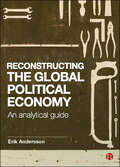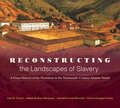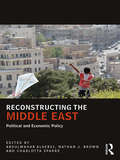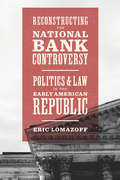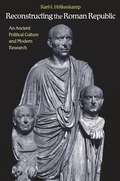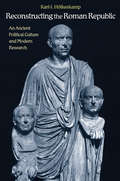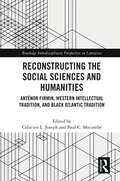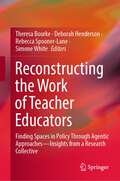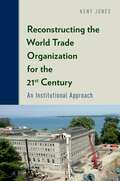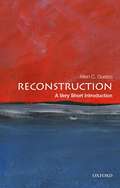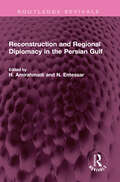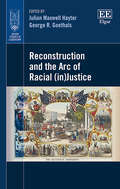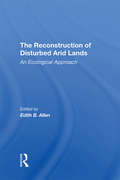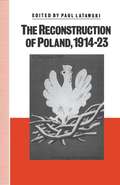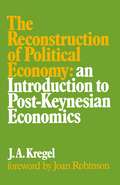- Table View
- List View
Reconstructing the Global Political Economy: An Analytical Guide
by Erik AnderssonIn an era of post-globalisation, the global political economy needs restructuring. This future-orientated textbook examines the challenges facing the world economy as a result of climate change, social and economic inequality and provides future-oriented solutions. Andersson clearly presents and explains key concepts from Global Political Economy (GPE) to show how these can be used to design and analyse potential reconstructions of the global political economy, offering the analytical tools and inroads to this reconstruction. With a comprehensive exploration of the different ideological pathways that change might take, through intersecting dimensions of gender, race and class, the author expertly guides the reader through thematic chapters such as: • The political economy of everyday life • Regulation of global trade • Post-development • Global value chain production • Financial markets This textbook will help students and non-specialist readers to see that global economic change is possible and show how core concepts from GPE can enable clear thinking about a global future that is environmentally, socially and economically sustainable.
Reconstructing the Landscapes of Slavery: A Visual History of the Plantation in the Nineteenth-Century Atlantic World
by Dale W. Tomich Reinaldo Funes Monzote Carlos Venegas Fornias Rafael de Bivar MarqueseAssessing a unique collection of more than eighty images, this innovative study of visual culture reveals the productive organization of plantation landscapes in the nineteenth-century Atlantic world. These landscapes—from cotton fields in the Lower Mississippi Valley to sugar plantations in western Cuba and coffee plantations in Brazil's Paraiba Valley—demonstrate how the restructuring of the capitalist world economy led to the formation of new zones of commodity production. By extension, these environments radically transformed slave labor and the role such labor played in the expansion of the global economy.Artists and mapmakers documented in surprising detail how the physical organization of the landscape itself made possible the increased exploitation of enslaved labor. Reading these images today, one sees how technologies combined with evolving conceptions of plantation management that reduced enslaved workers to black bodies. Planter control of enslaved people's lives and labor maximized the production of each crop in a calculated system of production. Nature, too, was affected: the massive increase in the scale of production and new systems of cultivation increased the land's output. Responding to world economic conditions, the replication of slave-based commodity production became integral to the creation of mass markets for cotton, sugar, and coffee, which remain at the center of contemporary life.
Reconstructing the Middle East: Political and Economic Policy (UCLA Center for Middle East Development (CMED) series)
by Abdulwahab Alkebsi Nathan J Brown Charlotta SparreIt is clear by now that the label ‘Arab Spring’ has proven too simplistic to describe the uprisings that upended the political order of the Arab world in late 2010. Brutal crackdowns and civil conflict in Syria, Libya, and Yemen dashed the hopes that peaceful democratic revolutions would sweep the region. In other countries, the departure of authoritarian leaders led to many false starts without producing democratic conclusions. Societies that had appeared united in opposition suddenly seemed fractious. Youth were once again banished to the political margins. ‘Reconstructing the Middle East’ examines the changes that happened within the region from 2010 and the long-term challenges and opportunities they present. Featuring the work of authors with a diversity of perspectives, most of whom hail from the region, it addresses key issues of political, economic and societal changes, the role of young people and of the international community. In addition, the book deals with the questions of both political and economic reform, and the intertwined nature of the two. Political reform that allows greater participation will fail to quell frustration if Arabs continue to feel that their job prospects are bleak. Similarly, Arabs will not accept economic reform that restores growth but continues to fence off the political sphere. This book offers a unique perspective on the uprisings by focusing on specific issue areas where change is needed, and offering a roadmap for the long road towards state building and new social contracts based on political inclusion, respect for pluralism, and sustained economic growth. As such, it will be a valuable resource for students and scholars of Middle East Politics, as well as those with an interest in the Arab Spring.
Reconstructing the Middle East: Political and Economic Policy (UCLA Center for Middle East Development (CMED) series)
by Abdulwahab Alkebsi Nathan J Brown Charlotta SparreIt is clear by now that the label ‘Arab Spring’ has proven too simplistic to describe the uprisings that upended the political order of the Arab world in late 2010. Brutal crackdowns and civil conflict in Syria, Libya, and Yemen dashed the hopes that peaceful democratic revolutions would sweep the region. In other countries, the departure of authoritarian leaders led to many false starts without producing democratic conclusions. Societies that had appeared united in opposition suddenly seemed fractious. Youth were once again banished to the political margins. ‘Reconstructing the Middle East’ examines the changes that happened within the region from 2010 and the long-term challenges and opportunities they present. Featuring the work of authors with a diversity of perspectives, most of whom hail from the region, it addresses key issues of political, economic and societal changes, the role of young people and of the international community. In addition, the book deals with the questions of both political and economic reform, and the intertwined nature of the two. Political reform that allows greater participation will fail to quell frustration if Arabs continue to feel that their job prospects are bleak. Similarly, Arabs will not accept economic reform that restores growth but continues to fence off the political sphere. This book offers a unique perspective on the uprisings by focusing on specific issue areas where change is needed, and offering a roadmap for the long road towards state building and new social contracts based on political inclusion, respect for pluralism, and sustained economic growth. As such, it will be a valuable resource for students and scholars of Middle East Politics, as well as those with an interest in the Arab Spring.
Reconstructing the National Bank Controversy: Politics and Law in the Early American Republic
by Eric LomazoffThe Bank of the United States sparked several rounds of intense debate over the meaning of the Constitution’s Necessary and Proper Clause, which authorizes the federal government to make laws that are “necessary” for exercising its other powers. Our standard account of the national bank controversy, however, is incomplete. The controversy was much more dynamic than a two-sided debate over a single constitutional provision and was shaped as much by politics as by law. With Reconstructing the National Bank Controversy, Eric Lomazoff offers a far more robust account of the constitutional politics of national banking between 1791 and 1832. During that time, three forces—changes within the Bank itself, growing tension over federal power within the Republican coalition, and the endurance of monetary turmoil beyond the War of 1812 —drove the development of our first major debate over the scope of federal power at least as much as the formal dimensions of the Constitution or the absence of a shared legal definition for the word “necessary.” These three forces—sometimes alone, sometimes in combination—repeatedly reshaped the terms on which the Bank’s constitutionality was contested. Lomazoff documents how these three dimensions of the polity changed over time and traces the manner in which they periodically led federal officials to adjust their claims about the Bank’s constitutionality. This includes the emergence of the Coinage Clause—which gives Congress power to “coin money, regulate the value thereof”—as a novel justification for the institution. He concludes the book by explaining why a more robust account of the national bank controversy can help us understand the constitutional basis for modern American monetary politics.
Reconstructing the National Bank Controversy: Politics and Law in the Early American Republic
by Eric LomazoffThe Bank of the United States sparked several rounds of intense debate over the meaning of the Constitution’s Necessary and Proper Clause, which authorizes the federal government to make laws that are “necessary” for exercising its other powers. Our standard account of the national bank controversy, however, is incomplete. The controversy was much more dynamic than a two-sided debate over a single constitutional provision and was shaped as much by politics as by law. With Reconstructing the National Bank Controversy, Eric Lomazoff offers a far more robust account of the constitutional politics of national banking between 1791 and 1832. During that time, three forces—changes within the Bank itself, growing tension over federal power within the Republican coalition, and the endurance of monetary turmoil beyond the War of 1812 —drove the development of our first major debate over the scope of federal power at least as much as the formal dimensions of the Constitution or the absence of a shared legal definition for the word “necessary.” These three forces—sometimes alone, sometimes in combination—repeatedly reshaped the terms on which the Bank’s constitutionality was contested. Lomazoff documents how these three dimensions of the polity changed over time and traces the manner in which they periodically led federal officials to adjust their claims about the Bank’s constitutionality. This includes the emergence of the Coinage Clause—which gives Congress power to “coin money, regulate the value thereof”—as a novel justification for the institution. He concludes the book by explaining why a more robust account of the national bank controversy can help us understand the constitutional basis for modern American monetary politics.
Reconstructing the National Bank Controversy: Politics and Law in the Early American Republic
by Eric LomazoffThe Bank of the United States sparked several rounds of intense debate over the meaning of the Constitution’s Necessary and Proper Clause, which authorizes the federal government to make laws that are “necessary” for exercising its other powers. Our standard account of the national bank controversy, however, is incomplete. The controversy was much more dynamic than a two-sided debate over a single constitutional provision and was shaped as much by politics as by law. With Reconstructing the National Bank Controversy, Eric Lomazoff offers a far more robust account of the constitutional politics of national banking between 1791 and 1832. During that time, three forces—changes within the Bank itself, growing tension over federal power within the Republican coalition, and the endurance of monetary turmoil beyond the War of 1812 —drove the development of our first major debate over the scope of federal power at least as much as the formal dimensions of the Constitution or the absence of a shared legal definition for the word “necessary.” These three forces—sometimes alone, sometimes in combination—repeatedly reshaped the terms on which the Bank’s constitutionality was contested. Lomazoff documents how these three dimensions of the polity changed over time and traces the manner in which they periodically led federal officials to adjust their claims about the Bank’s constitutionality. This includes the emergence of the Coinage Clause—which gives Congress power to “coin money, regulate the value thereof”—as a novel justification for the institution. He concludes the book by explaining why a more robust account of the national bank controversy can help us understand the constitutional basis for modern American monetary politics.
Reconstructing the National Bank Controversy: Politics and Law in the Early American Republic
by Eric LomazoffThe Bank of the United States sparked several rounds of intense debate over the meaning of the Constitution’s Necessary and Proper Clause, which authorizes the federal government to make laws that are “necessary” for exercising its other powers. Our standard account of the national bank controversy, however, is incomplete. The controversy was much more dynamic than a two-sided debate over a single constitutional provision and was shaped as much by politics as by law. With Reconstructing the National Bank Controversy, Eric Lomazoff offers a far more robust account of the constitutional politics of national banking between 1791 and 1832. During that time, three forces—changes within the Bank itself, growing tension over federal power within the Republican coalition, and the endurance of monetary turmoil beyond the War of 1812 —drove the development of our first major debate over the scope of federal power at least as much as the formal dimensions of the Constitution or the absence of a shared legal definition for the word “necessary.” These three forces—sometimes alone, sometimes in combination—repeatedly reshaped the terms on which the Bank’s constitutionality was contested. Lomazoff documents how these three dimensions of the polity changed over time and traces the manner in which they periodically led federal officials to adjust their claims about the Bank’s constitutionality. This includes the emergence of the Coinage Clause—which gives Congress power to “coin money, regulate the value thereof”—as a novel justification for the institution. He concludes the book by explaining why a more robust account of the national bank controversy can help us understand the constitutional basis for modern American monetary politics.
Reconstructing the National Bank Controversy: Politics and Law in the Early American Republic
by Eric LomazoffThe Bank of the United States sparked several rounds of intense debate over the meaning of the Constitution’s Necessary and Proper Clause, which authorizes the federal government to make laws that are “necessary” for exercising its other powers. Our standard account of the national bank controversy, however, is incomplete. The controversy was much more dynamic than a two-sided debate over a single constitutional provision and was shaped as much by politics as by law. With Reconstructing the National Bank Controversy, Eric Lomazoff offers a far more robust account of the constitutional politics of national banking between 1791 and 1832. During that time, three forces—changes within the Bank itself, growing tension over federal power within the Republican coalition, and the endurance of monetary turmoil beyond the War of 1812 —drove the development of our first major debate over the scope of federal power at least as much as the formal dimensions of the Constitution or the absence of a shared legal definition for the word “necessary.” These three forces—sometimes alone, sometimes in combination—repeatedly reshaped the terms on which the Bank’s constitutionality was contested. Lomazoff documents how these three dimensions of the polity changed over time and traces the manner in which they periodically led federal officials to adjust their claims about the Bank’s constitutionality. This includes the emergence of the Coinage Clause—which gives Congress power to “coin money, regulate the value thereof”—as a novel justification for the institution. He concludes the book by explaining why a more robust account of the national bank controversy can help us understand the constitutional basis for modern American monetary politics.
Reconstructing the National Bank Controversy: Politics and Law in the Early American Republic
by Eric LomazoffThe Bank of the United States sparked several rounds of intense debate over the meaning of the Constitution’s Necessary and Proper Clause, which authorizes the federal government to make laws that are “necessary” for exercising its other powers. Our standard account of the national bank controversy, however, is incomplete. The controversy was much more dynamic than a two-sided debate over a single constitutional provision and was shaped as much by politics as by law. With Reconstructing the National Bank Controversy, Eric Lomazoff offers a far more robust account of the constitutional politics of national banking between 1791 and 1832. During that time, three forces—changes within the Bank itself, growing tension over federal power within the Republican coalition, and the endurance of monetary turmoil beyond the War of 1812 —drove the development of our first major debate over the scope of federal power at least as much as the formal dimensions of the Constitution or the absence of a shared legal definition for the word “necessary.” These three forces—sometimes alone, sometimes in combination—repeatedly reshaped the terms on which the Bank’s constitutionality was contested. Lomazoff documents how these three dimensions of the polity changed over time and traces the manner in which they periodically led federal officials to adjust their claims about the Bank’s constitutionality. This includes the emergence of the Coinage Clause—which gives Congress power to “coin money, regulate the value thereof”—as a novel justification for the institution. He concludes the book by explaining why a more robust account of the national bank controversy can help us understand the constitutional basis for modern American monetary politics.
Reconstructing the Roman Republic: An Ancient Political Culture and Modern Research
by Karl-J. HölkeskampIn recent decades, scholars have argued that the Roman Republic's political culture was essentially democratic in nature, stressing the central role of the 'sovereign' people and their assemblies. Karl-J. Hölkeskamp challenges this view in Reconstructing the Roman Republic, warning that this scholarly trend threatens to become the new orthodoxy, and defending the position that the republic was in fact a uniquely Roman, dominantly oligarchic and aristocratic political form. Hölkeskamp offers a comprehensive, in-depth survey of the modern debate surrounding the Roman Republic. He looks at the ongoing controversy first triggered in the 1980s when the 'oligarchic orthodoxy' was called into question by the idea that the republic's political culture was a form of Greek-style democracy, and he considers the important theoretical and methodological advances of the 1960s and 1970s that prepared the ground for this debate. Hölkeskamp renews and refines the 'elitist' view, showing how the republic was a unique kind of premodern city-state political culture shaped by a specific variant of a political class. He covers a host of fascinating topics, including the Roman value system; the senatorial aristocracy; competition in war and politics within this aristocracy; and the symbolic language of public rituals and ceremonies, monuments, architecture, and urban topography. Certain to inspire continued debate, Reconstructing the Roman Republic offers fresh approaches to the study of the republic while attesting to the field's enduring vitality.Some images inside the book are unavailable due to digital copyright restrictions.
Reconstructing the Roman Republic: An Ancient Political Culture and Modern Research
by Karl-J. Hölkeskamp Henry Heitmann-GordonIn recent decades, scholars have argued that the Roman Republic's political culture was essentially democratic in nature, stressing the central role of the 'sovereign' people and their assemblies. Karl-J. Hölkeskamp challenges this view in Reconstructing the Roman Republic, warning that this scholarly trend threatens to become the new orthodoxy, and defending the position that the republic was in fact a uniquely Roman, dominantly oligarchic and aristocratic political form. Hölkeskamp offers a comprehensive, in-depth survey of the modern debate surrounding the Roman Republic. He looks at the ongoing controversy first triggered in the 1980s when the 'oligarchic orthodoxy' was called into question by the idea that the republic's political culture was a form of Greek-style democracy, and he considers the important theoretical and methodological advances of the 1960s and 1970s that prepared the ground for this debate. Hölkeskamp renews and refines the 'elitist' view, showing how the republic was a unique kind of premodern city-state political culture shaped by a specific variant of a political class. He covers a host of fascinating topics, including the Roman value system; the senatorial aristocracy; competition in war and politics within this aristocracy; and the symbolic language of public rituals and ceremonies, monuments, architecture, and urban topography. Certain to inspire continued debate, Reconstructing the Roman Republic offers fresh approaches to the study of the republic while attesting to the field's enduring vitality.
Reconstructing the Social Sciences and Humanities: Anténor Firmin, Western Intellectual Tradition, and Black Atlantic Tradition (Routledge Interdisciplinary Perspectives on Literature)
by Celucien L. JosephJoseph Antenor Firmin (1850-1911) was the reigning public intellectual and political critic in Haiti in the nineteenth-century. He was the first "Black anthropologist" and "Black Egyptologist" to deconstruct the Western interpretation of global history and challenge the ideological construction of human nature and theories of knowledge in Western social sciences and the humanities. As an anti-racist intellectual and cosmopolitan thinker, Firmin's writings challenge Western ideas of the colonial subject, race achievement, and modernity’s imagination of a linear narrative based on the false premises of social evolution and development, colonial history and epistemology, and the intellectual evolution of the Aryan-White race. Firmin articulated an alternative way to study global historical trajectories, the political life, human societies and interactions, and the diplomatic relations and dynamics between the nations and the races. Reconstructing the Social Sciences and Humanities is the first full-length book devoted to Joseph Antenor Firmin. It reexamines the importance of his thought and legacy, and its relevance for the twenty-first century’s culture of humanism, and the continuing challenge of race and racism.
Reconstructing the Social Sciences and Humanities: Anténor Firmin, Western Intellectual Tradition, and Black Atlantic Tradition (Routledge Interdisciplinary Perspectives on Literature)
by Celucien L. Joseph Paul C. MocombeJoseph Antenor Firmin (1850-1911) was the reigning public intellectual and political critic in Haiti in the nineteenth-century. He was the first "Black anthropologist" and "Black Egyptologist" to deconstruct the Western interpretation of global history and challenge the ideological construction of human nature and theories of knowledge in Western social sciences and the humanities. As an anti-racist intellectual and cosmopolitan thinker, Firmin's writings challenge Western ideas of the colonial subject, race achievement, and modernity’s imagination of a linear narrative based on the false premises of social evolution and development, colonial history and epistemology, and the intellectual evolution of the Aryan-White race. Firmin articulated an alternative way to study global historical trajectories, the political life, human societies and interactions, and the diplomatic relations and dynamics between the nations and the races. Reconstructing the Social Sciences and Humanities is the first full-length book devoted to Joseph Antenor Firmin. It reexamines the importance of his thought and legacy, and its relevance for the twenty-first century’s culture of humanism, and the continuing challenge of race and racism.
Reconstructing the Work of Teacher Educators: Finding Spaces in Policy Through Agentic Approaches —Insights from a Research Collective
by Theresa Bourke Deborah Henderson Rebecca Spooner-Lane Simone WhiteThis book examines agentic approaches by which teacher educators navigate a highly regulated environment. It investigates how teacher educators are responding to such regulation by employing approaches such as exploratory and case study research designs. This book analyzes qualitative and quantitative data to understand the diverse, innovative and critical perspectives of teacher educators who are guided by state and federal level initiatives to enhance the quality Initial Teacher Education (ITE) programs. Prominent educational theoretical perspectives are also used in this book to inform data analysis and to illuminate the empirically based findings.This book showcases research-informed insights for the global education community from leading researchers from across a number of teacher education institutions, locally and otherwise. By adopting an ‘activist’ approach, this book positions teacher educators’ research and contribution to the field as agentive and pro-active.
Reconstructing the World Trade Organization for the 21st Century: An Institutional Approach
by Kent JonesThe institutional shortcomings of the World Trade Organization (WTO) became apparent during the Doha Round of Trade negotiations that began in 2001 and which aimed to improve the success of developing countries' trading by lowering trade barriers and adjusting other trade rules. This "development agenda" meant different things to rich and poor countries. In addition, many of the circumstances that supported success in General Agreement on Tariffs and Trade (GATT) negotiations of 1947 were no longer present after the WTO was founded in 1995. In Reconstructing the World Trade Organization for the 21st Century, Kent Jones examines the difficulties of the WTO in completing multilateral trade negotiations and possible ways to restore its ability to do so. The problem lies in the institutional structure it inherited from the GATT, which was designed for a more limited scope of trade negotiations among a relatively small number of wealthier, industrialized countries. Jones presents an institutional model of the GATT/WTO system, which describes why such an organization exists and how it is supposed to accomplish its goals. Institutional reforms will be necessary to restore the WTO's ability to complete global trade agreements, including a more flexible application of the consensus rule, a common understanding among all members about the limits of domestic policy space that is subject to negotiation, and clearer rules on reciprocity obligations. The popularity of bilateral and regional trade agreements, which have emerged as the alternative to WTO agreements, presents a threat to the WTO's relevance in trade negotiations, but also an opportunity to "multilateralize" new and deeper trade integration in future WTO agreements. Aid for trade may also play an instrumental role in bringing more developing countries into WTO disciplines. Above all, WTO members must develop new ways to find common ground in order to negotiate for mutual gains from trade.
Reconstructing the World Trade Organization for the 21st Century: An Institutional Approach
by Kent JonesThe institutional shortcomings of the World Trade Organization (WTO) became apparent during the Doha Round of Trade negotiations that began in 2001 and which aimed to improve the success of developing countries' trading by lowering trade barriers and adjusting other trade rules. This "development agenda" meant different things to rich and poor countries. In addition, many of the circumstances that supported success in General Agreement on Tariffs and Trade (GATT) negotiations of 1947 were no longer present after the WTO was founded in 1995. In Reconstructing the World Trade Organization for the 21st Century, Kent Jones examines the difficulties of the WTO in completing multilateral trade negotiations and possible ways to restore its ability to do so. The problem lies in the institutional structure it inherited from the GATT, which was designed for a more limited scope of trade negotiations among a relatively small number of wealthier, industrialized countries. Jones presents an institutional model of the GATT/WTO system, which describes why such an organization exists and how it is supposed to accomplish its goals. Institutional reforms will be necessary to restore the WTO's ability to complete global trade agreements, including a more flexible application of the consensus rule, a common understanding among all members about the limits of domestic policy space that is subject to negotiation, and clearer rules on reciprocity obligations. The popularity of bilateral and regional trade agreements, which have emerged as the alternative to WTO agreements, presents a threat to the WTO's relevance in trade negotiations, but also an opportunity to "multilateralize" new and deeper trade integration in future WTO agreements. Aid for trade may also play an instrumental role in bringing more developing countries into WTO disciplines. Above all, WTO members must develop new ways to find common ground in order to negotiate for mutual gains from trade.
Reconstruction: A Concise History (Very Short Introductions)
by Allen C. GuelzoThe era known as Reconstruction is one of the unhappiest times in American history. It succeeded in reuniting the nation politically after the Civil War but in little else. Among its chief failures was the inability to chart a progressive course for race relations after the abolition of slavery and rise of Jim Crow. Reconstruction also struggled to successfully manage the Southern resistance towards a Northern, free-labor pattern. But the failures cannot obscure a number of notable accomplishments, with decisive long-term consequences for American life: the 14th and 15th Amendments to the Constitution, the election of the first African American representatives to the US Congress, and the avoidance of any renewed outbreak of civil war. Reconstruction suffered from poor leadership and uncertainty of direction, but it also laid the groundwork for renewed struggles for racial equality during the Civil Rights Movement. This Very Short Introduction delves into the constitutional, political, and social issues behind Reconstruction to provide a lucid and original account of a historical moment that left an indelible mark on American social fabric. Award-winning historian Allen C. Guelzo depicts Reconstruction as a "bourgeois revolution" -- as the attempted extension of the free-labor ideology embodied by Lincoln and the Republican Party to what was perceived as a Southern region gone astray from the Founders' intention in the pursuit of Romantic aristocracy. ABOUT THE SERIES: The Very Short Introductions series from Oxford University Press contains hundreds of titles in almost every subject area. These pocket-sized books are the perfect way to get ahead in a new subject quickly. Our expert authors combine facts, analysis, perspective, new ideas, and enthusiasm to make interesting and challenging topics highly readable.
Reconstruction and Regional Diplomacy in the Persian Gulf (Routledge Revivals)
by H. Amirahmadi N. EntessarFirst Published in 1992 Reconstruction and Regional Diplomacy in the Persian Gulf goes beyond a description of the recent events by analysing the social, political, and economic patterns of interaction between the Gulf states. The argument is strengthened by a consideration of the role of the superpowers in the region’s political discourse, and of religion as a force for a change. Not only do the authors provide an easily accessible basis for explaining the current problems in the region, but they also offer their own, sometimes provocative policy prescriptions. This book is an important read for scholars and researchers of Middle East politics and Middle East history.
Reconstruction and Regional Diplomacy in the Persian Gulf (Routledge Revivals)
First Published in 1992 Reconstruction and Regional Diplomacy in the Persian Gulf goes beyond a description of the recent events by analysing the social, political, and economic patterns of interaction between the Gulf states. The argument is strengthened by a consideration of the role of the superpowers in the region’s political discourse, and of religion as a force for a change. Not only do the authors provide an easily accessible basis for explaining the current problems in the region, but they also offer their own, sometimes provocative policy prescriptions. This book is an important read for scholars and researchers of Middle East politics and Middle East history.
Reconstruction and the Arc of Racial (Jepson Studies in Leadership series)
by Julian M. Hayter George R. GoethalsThis collection of original essays and commentary considers not merely how history has shaped the continuing struggle for racial equality, but also how backlash and resistance to racial reforms continue to dictate the state of race in America. Informed by a broad historical perspective, this book focuses primarily on the promise of Reconstruction and the long demise of that promise. It traces the history of struggles for racial justice from the post US Civil War Reconstruction through the Jim Crow era, the Civil Rights and Voting Rights decades of the 1950s and 1960s to the present day. The book uses psychological, historical and political perspectives to put today’s struggles for justice in historical perspective, considering intersecting dynamics of race and class in inequality and the different ways that people understand history. Ultimately, the authors question Martin Luther King, Jr.’s contention that the moral arc of the universe bends toward justice, challenging portrayals of race relations and the realization of civil rights laws as a triumph narrative. Scholars in history, political science and psychology, as well as graduate students in these fields, can use the issues explored in this book as a foundation for their own work on race, justice and American history.
The Reconstruction Of Disturbed Arid Lands: An Ecological Approach
by Edith B. AllenThis volume emphasizes application of the basic ecological relationships among plants, animals, microorganisms, the physical environment and man to reconstruct wildland ecosystems. It contains the proceedings of a symposium sponsored by the American Association for the Advancement of Science.
The Reconstruction Of Disturbed Arid Lands: An Ecological Approach
by Edith B. AllenThis volume emphasizes application of the basic ecological relationships among plants, animals, microorganisms, the physical environment and man to reconstruct wildland ecosystems. It contains the proceedings of a symposium sponsored by the American Association for the Advancement of Science.
The Reconstruction of Poland, 1914-23 (Studies in Russia and East Europe)
by Paul LatawskiThe Reconstruction of Poland, 1914-23 is a significant reappraisal of the political, social and economic problems associated with the rebirth of an independent Polish state. The book spans a chronological period beginning in the First World War and culminates in the de jure recognition of the last of Poland's borders in 1923. This book provides essential background for the more recent attempt to rebuild Poland in the 1990s.
